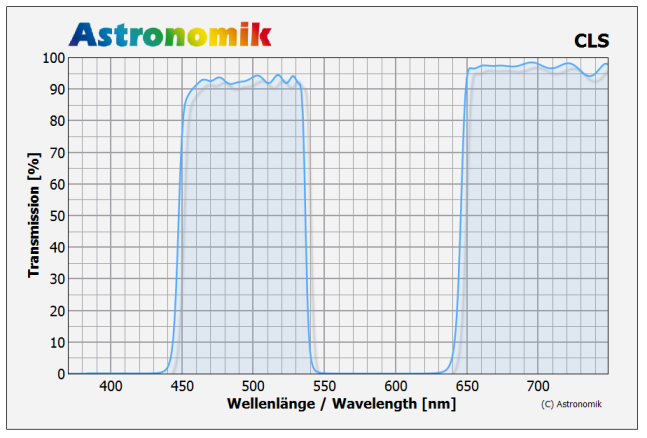About this product
Model: ak_cls_125
Part Number: 10213125
The Astronomik CLS is an excellent choice for visual observation, Black & White photography and CCD photographs of nebulae, galaxies and star clusters with astronomical instruments of any size.
The Astronomik CLS blocks the light of the spectral lines of mercury and sodium-vapour lamps and lets the largest part of the visible light and H-alpha emissions pass. All the important emission lines, as well as the spectral region that the very well dark adapted eye can see, can pass through the filter.
FEATURES
- 92% transmission at 486nm (H-beta)
- 92% transmission at 496nm (OIII)
- 92% transmission at 501nm (OIII)
- 97% transmission at 656nm (H alpha)
- Pass from 450 to 540nm and beyond 650nm
- Not sensitive to high humidity or ageing effects
- Scratch-resistance!
- Excellent quality substrate, diffraction limited - the optical performance of your telescope will not be reduced
- Parfocal with other Astronomik filters
- 1mm Glass Thickness
- Supplied in a high-quality, long lasting, filter box
Main use
The filters are optimised for use with aperture ratios from 1:3 to 1:15. Transmission losses and chromatic distortions, which are problems with other filters, only appear with Astronomik filters when extremely bright aperture ratios of 1:2 and more are used.
The CLS filter is suitable for use with telescopes of all aperture sizes.
Transmission Chart

- The horizontal axis is the Wavelength in Nanometers (nm). 400nm is deep blue, at 520nm the human eye senses green and at 600nm red. At 656nm is the famous "H-Alpha" emission line of hydrogen.
- The transmission in % is plotted on the vertical axis.
- The blue line shows the transmission of the filter.
- The most important emission lines from nebulas are shown in orange. The most important lines are from ionised Hydrogen (H-alpha and H-beta) and double ionised oxygen (OIII).
The major emission lines of artificial light pollution:
| Hg 435,8nm | Hg 546,1nm | Hg 577,0nm | Hg 578,1nm |
| Na 589,0nm | Na 589,6nm | Na 615,4nm | Na 616,1nm |
The major emission lines of nebulas:
H-β 486,1nm | OIII 495,9nm | OIII 500,7nm | H-α 656,3nm
Suitability
- Visual observation (dark skies): Good, to reduce light pollution by mercury-vapour lamps (streetlight)
- Visual observation (urban skies): Good, an UHC-E or UHC filter is more suitable
- Film photography: Very good, colour balance is near perfect
- CCD photography: Good, when used with an additional IR-block-filter
- DSLR photography (original): Good, colour balance shifted but contrast enhanced
- DSLR photography (astro modified): Very good, colour balance is near perfect
- DSLR photography (MC modified): Good, when used with an additional IR-block-filter
- Webcam / Video (Planets): Unsuitable
- Webcam / Video (Deep Sky): Very good, if light pollution is a big problem
Technical Data
- 92% transmission at 486nm (H-beta)
- 92% transmission at 496nm (OIII)
- 92% transmission at 501nm (OIII)
- 97% transmission at 656nm (H alpha)
- Pass from 450 to 540nm and beyond 650nm
- Scratch-resistant!
- Excellent carrier material. The optical performance of your telescope is not reduced by the filter in any way.
- Parfocal with other Astronomik filters
- Glass thickness: 1mm
- Completely resistant against high humidity, scratches and ageing effects
- Diffraction limited, the filter will not reduce the optical performance of your telescope!
- Astronomik filters are delivered in a high-quality, long lasting, filter box
Customer reviews
FAQ
Please fill in the form below to ask a question.